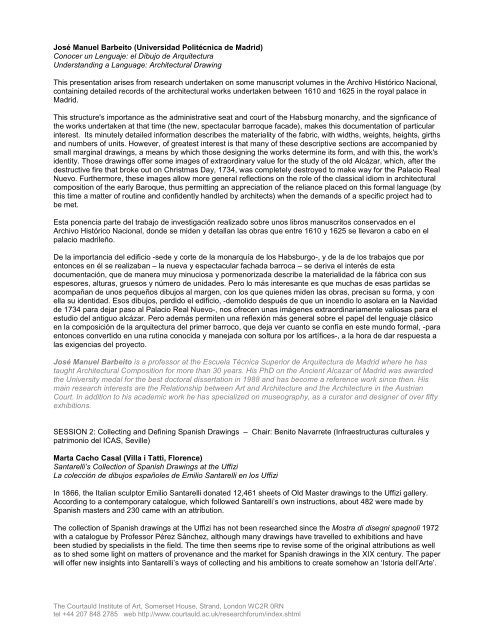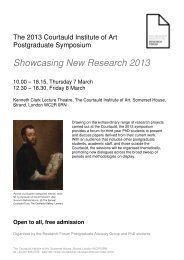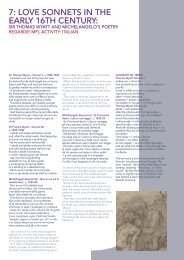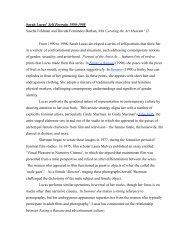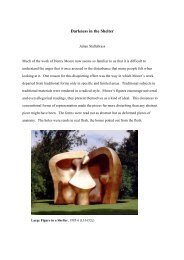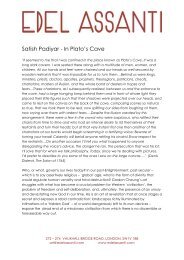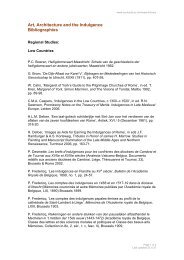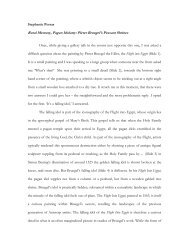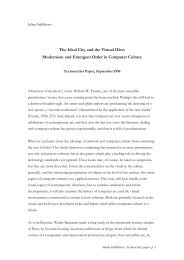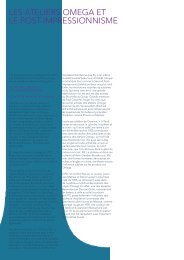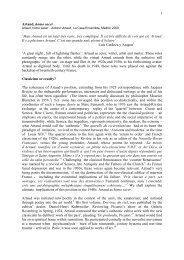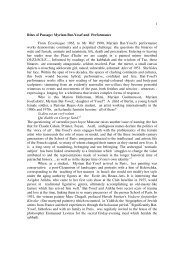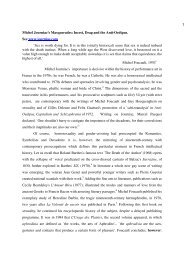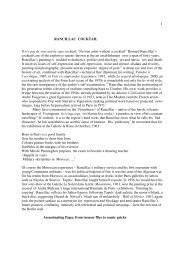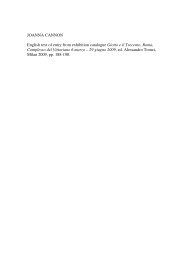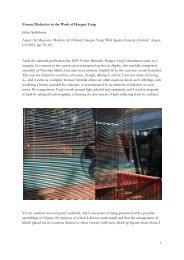Drawn to spain - The Courtauld Institute of Art
Drawn to spain - The Courtauld Institute of Art
Drawn to spain - The Courtauld Institute of Art
You also want an ePaper? Increase the reach of your titles
YUMPU automatically turns print PDFs into web optimized ePapers that Google loves.
José Manuel Barbei<strong>to</strong> (Universidad Politécnica de Madrid)<br />
Conocer un Lenguaje: el Dibujo de Arquitectura<br />
Understanding a Language: Architectural Drawing<br />
This presentation arises from research undertaken on some manuscript volumes in the Archivo Histórico Nacional,<br />
containing detailed records <strong>of</strong> the architectural works undertaken between 1610 and 1625 in the royal palace in<br />
Madrid.<br />
This structure's importance as the administrative seat and court <strong>of</strong> the Habsburg monarchy, and the signficance <strong>of</strong><br />
the works undertaken at that time (the new, spectacular barroque facade), makes this documentation <strong>of</strong> particular<br />
interest. Its minutely detailed information describes the materiality <strong>of</strong> the fabric, with widths, weights, heights, girths<br />
and numbers <strong>of</strong> units. However, <strong>of</strong> greatest interest is that many <strong>of</strong> these descriptive sections are accompanied by<br />
small marginal drawings, a means by which those designing the works determine its form, and with this, the work's<br />
identity. Those drawings <strong>of</strong>fer some images <strong>of</strong> extraordinary value for the study <strong>of</strong> the old Alcázar, which, after the<br />
destructive fire that broke out on Christmas Day, 1734, was completely destroyed <strong>to</strong> make way for the Palacio Real<br />
Nuevo. Furthermore, these images allow more general reflections on the role <strong>of</strong> the classical idiom in architectural<br />
composition <strong>of</strong> the early Baroque, thus permitting an appreciation <strong>of</strong> the reliance placed on this formal language (by<br />
this time a matter <strong>of</strong> routine and confidently handled by architects) when the demands <strong>of</strong> a specific project had <strong>to</strong><br />
be met.<br />
Esta ponencia parte del trabajo de investigación realizado sobre unos libros manuscri<strong>to</strong>s conservados en el<br />
Archivo Histórico Nacional, donde se miden y detallan las obras que entre 1610 y 1625 se llevaron a cabo en el<br />
palacio madrileño.<br />
De la importancia del edificio -sede y corte de la monarquía de los Habsburgo-, y de la de los trabajos que por<br />
en<strong>to</strong>nces en él se realizaban – la nueva y espectacular fachada barroca – se deriva el interés de esta<br />
documentación, que de manera muy minuciosa y pormenorizada describe la materialidad de la fábrica con sus<br />
espesores, alturas, gruesos y número de unidades. Pero lo más interesante es que muchas de esas partidas se<br />
acompañan de unos pequeños dibujos al margen, con los que quienes miden las obras, precisan su forma, y con<br />
ella su identidad. Esos dibujos, perdido el edificio, -demolido después de que un incendio lo asolara en la Navidad<br />
de 1734 para dejar paso al Palacio Real Nuevo-, nos <strong>of</strong>recen unas imágenes extraordinariamente valiosas para el<br />
estudio del antiguo alcázar. Pero además permiten una reflexión más general sobre el papel del lenguaje clásico<br />
en la composición de la arquitectura del primer barroco, que deja ver cuan<strong>to</strong> se confía en este mundo formal, -para<br />
en<strong>to</strong>nces convertido en una rutina conocida y manejada con soltura por los artífices-, a la hora de dar respuesta a<br />
las exigencias del proyec<strong>to</strong>.<br />
José Manuel Barbei<strong>to</strong> is a pr<strong>of</strong>essor at the Escuela Técnica Superior de Arquitectura de Madrid where he has<br />
taught Architectural Composition for more than 30 years. His PhD on the Ancient Alcazar <strong>of</strong> Madrid was awarded<br />
the University medal for the best doc<strong>to</strong>ral dissertation in 1988 and has become a reference work since then. His<br />
main research interests are the Relationship between <strong>Art</strong> and Architecture and the Architecture in the Austrian<br />
Court. In addition <strong>to</strong> his academic work he has specialized on museography, as a cura<strong>to</strong>r and designer <strong>of</strong> over fifty<br />
exhibitions.<br />
SESSION 2: Collecting and Defining Spanish Drawings – Chair: Beni<strong>to</strong> Navarrete (Infraestructuras culturales y<br />
patrimonio del ICAS, Seville)<br />
Marta Cacho Casal (Villa i Tatti, Florence)<br />
Santarelli’s Collection <strong>of</strong> Spanish Drawings at the Uffizi<br />
La colección de dibujos españoles de Emilio Santarelli en los Uffizi<br />
In 1866, the Italian sculp<strong>to</strong>r Emilio Santarelli donated 12,461 sheets <strong>of</strong> Old Master drawings <strong>to</strong> the Uffizi gallery.<br />
According <strong>to</strong> a contemporary catalogue, which followed Santarelli’s own instructions, about 482 were made by<br />
Spanish masters and 230 came with an attribution.<br />
<strong>The</strong> collection <strong>of</strong> Spanish drawings at the Uffizi has not been researched since the Mostra di disegni spagnoli 1972<br />
with a catalogue by Pr<strong>of</strong>essor Pérez Sánchez, although many drawings have travelled <strong>to</strong> exhibitions and have<br />
been studied by specialists in the field. <strong>The</strong> time then seems ripe <strong>to</strong> revise some <strong>of</strong> the original attributions as well<br />
as <strong>to</strong> shed some light on matters <strong>of</strong> provenance and the market for Spanish drawings in the XIX century. <strong>The</strong> paper<br />
will <strong>of</strong>fer new insights in<strong>to</strong> Santarelli’s ways <strong>of</strong> collecting and his ambitions <strong>to</strong> create somehow an ‘Is<strong>to</strong>ria dell’<strong>Art</strong>e’.<br />
<strong>The</strong> <strong>Courtauld</strong> <strong>Institute</strong> <strong>of</strong> <strong>Art</strong>, Somerset House, Strand, London WC2R 0RN<br />
tel +44 207 848 2785 web http://www.courtauld.ac.uk/researchforum/index.shtml


